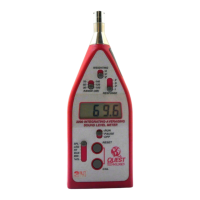MIN HOLD MIN, A,C or Z, Holds MIN until RESET
RUN, RESPONSE of or Meter SETTING is
FAST, SLOW OR changed
IMPULSE
During an LEQ RUN, weighting, response, and range switch settings can
not be changed. If these switches are changed, the LEQ measurement will
stop, reset, and start again.
4. OPERATION
Before taking measurements, there is a series of quick checks that should be
performed. After switching the unit ON check for a LOBAT indication on
the display, and replace the battery if needed (see Section 3.1).
Although the model 1200 will maintain accurate calibration over a long
period of time, the calibration should be checked before each use. The
calibration should also be checked and verified after each use.
Set the RESPONSE, WEIGHTING, and RANGE (dB) switches as needed.
Hold, set, or tripod mount the meter in the desired location. If a MAX,
MIN, or LEQ measurement is needed, be sure to reset the meter before
taking the measurements. It is good practice to document all measurement
conditions and meter settings for possible future reference.
4.1 Meter/Microphone Placement:
Whenever possible, the meter should be tripod-mounted in a relatively open
area to minimize reflections from the body or other large reflective
structures. Avoid placement against a wall or in a corner. A threaded
bushing on the back will accept a standard 1/4-20 tripod fitting.
The microphone cartridge used on the models 1200 and 2200 is a free-field
microphone. Point it directly at the noise source (0 degrees ).
Random incidence measurements may be taken with the 1200 if the plastic
random incidence corrector supplied with the BK4936 microphone is used.
The random incidence corrector is a black plastic lipped sleeve packed in
the BK4936 packing container. To attach the corrector, position the end of
the sleeve without the lip over the grid of the microphone and gently press
down until a snap fit is achieved.
4.2 Background Noise:
Background noise can cause considerable error in measurement when its
level is close to that of the particular sound source of interest. When it is not
possible to eliminate or reduce the background noise, use the curve shown
in Figure 3 to correct for the effect of the background noise on the
measurement.

